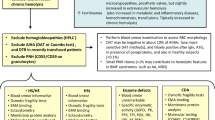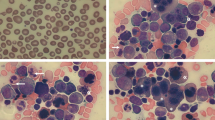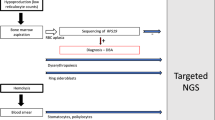Abstract
The congenital dyserythropoietic anemias (CDAs) comprise a group of rare hereditary disorders of erythropoiesis, characterized by ineffective erythropoiesis as the predominant mechanism of anemia and by distinct morphological abnormalities of the majority of erythroblasts in the bone marrow. The classification in three types as proposed in 1968 is still valid, but there is genetic heterogeneity within each type, and there are additional variants of unknown genetic basis. CDA II is the most frequent, and the nonfamilial type of CDA III the rarest group. The genes of CDA II and CDA III were mapped to chromosome 20 and 15, respectively, and the gene of CDA I on 15q was recently cloned. Therapeutic decision making requires definition of the type, an estimate of individual severity, and presence of or risk for complications. Therapeutic measures include interferon-α for CDA I, splenectomy for CDA II, and iron depletion for all individuals at risk for secondary hemochromatosis.
Similar content being viewed by others
Notes
For microphotographs see http://www.bone-marrow-failure-syndromes.de.
References
Adams CD, Kessler JF (1991) Circulating nucleated red blood cells following splenectomy in a patient with congenital dyserythropoietic anemia. Am J Hematol 38:120–123
Alloisio N, Texier P, Denoroy L, Berger C, Miraglia del Giudice E, Perrotta S, Iolascon A, Gilsanz F, Berger G, Guichard J (1996) The cisternae decorating the red blood cell membrane in congenital dyserythropoietic anemia (type II) originate from the endoplasmic reticulum. Blood 87:4433–4439
Anselstetter V, Horstmann K, Heimpel H (1977) Congenital dyserythropoetic anaemia, types I and II: aberrant pattern of erythrocyte membrane proteins in CDA II, as revealed by two-dimensional polyacrylamide gel electrophoresis. Br J Haematol 35:209–215
Ayas M, al Jefri A, Baothman A, al Mahr M, Mustafa MM, Khalil S, Karaoui M, Solh H (2002) Transfusion-dependent congenital dyserythropoietic anemia type I successfully treated with allogeneic stem cell transplantation. Bone Marrow Transplant 29:681–682
Barosi G, Cazzola M, Stefannelli M, Ascari E (1979) Studies of ineffective erythropoiesis and peripheral haemolysis in congenital dyserythropoietic anaemia type II. Br J Haematol 43:243–250
Benjamin JT, Rosse WF, Dalldorf FG, Mc Millan CW (1975) Congenital dyserythropoetic anemia—type IV. J Pediatr 87:210–216
Bergström I, Jacobsson L (1962) Hereditary benign erythroreticulosis. Blood 19:296–303
Bethlenfalvay NC, Hadnagy GS, Heimpel H (1985) Unclassified type of congenital dyserythropoietic anemia (CDA) with prominent peripheral erythoblastosis. Br J Haematol 60:541–550
Bethlenfalvay NC, Phaure TAJ, Phlyliky RL, Bowman RP (1986) Nuclear bridging of erythroblasts in acquired dyserythropoesis: an early and transient preleukemic marker. Am J Hematol 21:315–322
Bird AR, Karabus CD, Hartley PS (1985) Type IV congenital dyserythropoietic anemia with unusual response to splenectomy. Am J Pediatr Hematol Oncol 7:196–199
Boogaerts MA, Verwilghen RL (1982) Variants of congenital dyserythropoietic anaemia: an update. Haematologica (Budapest) 15:211–219
Breton-Gorius J, Daniel M, Clauvel JP, Dreyfus B (1973) Anomalies ultrastructurales des érythroblastes et des érythrocytes dans six cas de dysérythropoièse congénitale. Nouv Rev Fr Hematol 13:23–50
Byrnes RK, Dhru R, Brady AM, Galen WP, Hopper B (1980) Congenital dyserythropoietic anemia in treated Hodgkin’s disease. Hum Pathol 11:485–486
Carter C, Darbyshire PJ, Wickramasinghe SN (1989) A congenital dyserythropoietic anaemia variant presenting as hydrops foetalis. Br J Haematol 72:289–290
Cazzola M, Barosi G, Bergamaschi G, Dezza L, Palestra P, Polino G, Ramella S, Spriano P, Ascari E (1983) Iron loading in congenital dyserythropoietic anaemias and congenital sideroblastic anaemias. Br J Haematol 54:649–654
Cazzola M, Beguin Y, Bergamaschi G, Guarnone R, Cerani P, Barella S, Cao A, Galanello R (1999) Soluble transferrin receptor as a potential determinant of iron loading in congenital anaemias due to ineffective erythropoiesis. Br J Haematol 106:752–755
Chrobak L, Spacek J (1997) Favorable effect of splenectomy on anemia in 3 siblings with type II congenital dyserythropoietic anemia (HEMPAS). Ultrastructural changes in erythrocytes after splenectomy. Vnitr Lek 43:635–638
Clauvel JP, Cosson A, Breton-Gorius J, Flandrin G, Faille A, Bonnet-Gajdos M, Turpin F, Bernard J (1972) Dysérythropoièse congénitale. Nouv Rev Fr Hematol 12:653–672
Crookston JH, Crookston MC (1982) HEMPAS: clinical, hematological and serologic features. In: Salmon C (ed) Blood groups and other red cell markers in health and disease. Masson, New York, pp 29–38
Crookston JH, Godwin TF, Wightmann KJR, Dacie JV, Lewis SM, Patterson M (1966) Congenital dyserythropoietic anemia (abstract). XIth Congress of the International Society of Hematology, Sydney
Crookston JH, Crookston MC, Burnie KL, Francombe WH, Dacie JV, Davis JA, Lewis SM (1969) Hereditary erythroblastic multinuclearity associated with a positive acidified-serum test: a type of congenital dyserythropoietic anemia. Br J Haematol 17:11–26
David G, VanDorpe A (1977) Aberrant congenital dyserythropoietic anemias. In: Lewis SM, Verwilghen RL (eds) Dyserythropoiesis. Academic, London, pp 92–102
Delaunay J, Iolascon A (1999) The congenital dyserythropoietic anaemias. Baillieres Best Pract Res Clin Haematol 12:691–705
Dgany O, Avidan N, Delaunay J, Krasnov T, Shalmon L, Shalev H, Eidelitz-Markus T, Kapelushnik J, Cattan D, Pariente A, Tulliez M, Cretien A, Schischmanoff PO, Iolascon A, Fibach E, Koren A, Rossler J, Le Merrer M, Yaniv I, Zaizov R, Ben Asher E, Olender T, Lancet D, Beckmann JS, Tamary H (2002) Congenital dyserythropoietic anemia type I is caused by mutations in codanin-1. Am J Hum Genet 71:1467–1474
Eldor A, Matzner Y, Kahane I, Levene C, Polliack A (1978) Aberrant congenital dyserythropoietic anemia with negative acidified serum tests and features of thalassemia in a Kurdish family. Isr J Med Sci 14:1138–1143
Enquist RW, Gockerman JP, Jenis EH, Warkel RL, Dillon DE (1972) Type II congenital dyserythropoietic anemia. Ann Intern Med 77:371–376
Erdmann H, Heimpel H, Buchta H (1970) Positiver Säureserumtest und erhöhte Agglutinabilität durch Anti-i bei Patienten mit kongenitaler dyserythropoietischer Anämie. Klin Wochenschr 48:569–570
Facon T, Mannessier L, Lepelly P, Weill J, Fenaux P, Dupriez B, Morel P, Jouet JP, Lepelley P (1990) Congenital dyserythropoietic anemia type I. Report on monozygotic twins with associated hemochromatosis and short stature. Blut 61:248–251
Faille A, Najean Y, Dresch C (1972) Cinétique de l’érythropoièse dans 14 cas “d’érythropoièse inefficace” avec anomalies morphologiques des érythroblastes et polynucléarité. Nouv Rev Fr Hematol 12:631–652
Fischer R, Tiemann CD, Engelhardt R, Nielsen P, Durken M, Gabbe EE, Janka GE (1999) Assessment of iron stores in children with transfusion siderosis by biomagnetic liver susceptometry. Am J Hematol 60:289–299
Franchini M, Gandini G, Girelli D, Lippi G, de Gironcoli M, Aprili G (2001) Association of phlebotomy and subcutaneous bolus injection of deferoxamine for the treatment of anemic patients with iron overload. Haematologica 86:873–874
Fukuda MN (1993) Congenital dyserythropoietic anaemia type II (HEMPAS) and its molecular basis. Ballieres Clin Haematol 6:493–511
Fukuda MN (1999) HEMPAS. Hereditary erythroblastic multinuclearity with positive acidified serum lysis test. Biochim Biophys Acta 1455:231–239
Fukuda MN, Dell A, Scartezzini P (1987) Primary defect of congenital dyserythropoietic anemia type II. Failure in glycosylation of erythrocyte lactosaminoglycan proteins caused by lowered N-acetylglucosaminyltransferase II. J Biol Chem 262:7195–7206
Gasser C (1981) Congenital-dyserythropoietic-malformation syndrome (abstract). 6th meeting of the International Society of Hematology, Athens
Greiner TC, Burns CP, Dick FR, Henry KM, Mahmood I (1992) Congenital dyserythropoietic anemia type II diagnosed in a 69-year-old patient with iron overload. Am J Clin Pathol 98:522–525
Heimpel H (1975) Dyserythropoiese und dyserythropoietische Anämien. Schweiz Med Wochenschr 105:1562–1568
Heimpel H, Wendt F (1968) Congenital dyserythropoietic anemia with karyorrhexis and multinuclearity of erythroblasts. Helv Med Acta 34:103–115
Heimpel H, Wendt F, Klemm D, Schubothe H, Heilmeyer L (1968) Kongenitale dyserythropoietische Anämie. Dtsch Arch Klin Med 215:174–194
Heimpel H, Forteza-Vila J, Queisser W (1970) Morphological aberrations of the erythroblasts in congenital dyserythropoietic anemia type I and II (abstract). XIIIth International Congress of the International Society of Hematology, Munich, p 371
Heimpel H, Forteza-Vila J, Queisser W, Spiertz E (1971) Electron and light microscopic study of the erythropoiesis of patients with congenital dyserythropoietic anemia. Blood 37:299–310
Heimpel H, Maier K, Kohne E (1999) Kongenitale dyserythropoietische Anämien: Klinisches Bild und neue Erkenntnisse zu Epidemiologie, Pathogenese und Behandlung. Monatsschr Kinderheilkd 147:992–999
Heimpel H, Eggl C, Griesshammer A, Maier K, Kohne E (2002) Splenectomy in congenital dyserythropoietic anemia (abstract). Egypt J Haematol 27 [Suppl 1]:83–84
Heimpel H, Anselstetter V, Chrobak L, Denecke J, Einsiedler B, Gallmeier K, Griesshammer A, Marquardt T, Janka-Schaub G, Kron M, Kohne E (2003) Congenital dyserythropoietic anemia type II: epidemiology, clinical appearance, and prognosis based on long-term observation. Blood 102:4576–4581
Hodges VM, Molloy GY, Wickramasinghe SN (1999) Genetic heterogeneity of congenital dyserythropoietic anemia type I (letter). Blood 94:1139–1140
Hofmann WK, Kaltwasser JP, Hoelzer D, Nielsen P, Gabbe EE (1997) Successful treatment of iron overload by phlebotomies in a patient with severe congenital dyserythropoietic anemia type II (letter). Blood 89:3068–3069
Holmberg L, Jansson L, Rausing A, Henriksson P (1978) Type I congenital dyserythropoietic anaemia with myelopoietic abnormalities and hand malformations. Scand J Haematol 21:72–79
Hovinga JA, Solenthaler M, Dufour JF (2003) Congenital dyserythropoietic anaemia type II (HEMPAS) and haemochromatosis: a report of two cases. Eur J Gastroenterol Hepatol 15:1141–1147
Iolascon A, D’Agostaro G, Perrotta S, Izzo P, Tavano R, Miraglia del Giudice B (1996) Congenital dyserythropoietic anemia type II: molecular basis and clinical aspects. Haematologica 81:543–559
Iolascon A, Miraglia del Giudice E, Perrotta S, Granatiero M, Zelante L, Gasparini P (1997) Exclusion of three candidate genes as determinants of congenital dyserythropoietic anemia type II (CDA-II). Blood 90:4197–4200
Iolascon A, De Mattia D, Perrotta S, Carella M, Gasparini P, Lambertenghi Deliliers G (1998) Genetic heterogeneity of congenital dyserythropoietic anemia type II (letter). Blood 92:2593–2594
Iolascon A, Servedio V, Carbone R, Totaro A, Carella M, Perrotta S, Wickramasinghe SN, Delaunay J, Heimpel H, Gasparini P (2000) Geographic distribution of CDA-II: did a founder effect operate in Southern Italy? Haematologica 85:470–474
Iolascon A, Delaunay J, Wickramasinghe SN, Perrotta S, Gigante M, Camaschella C (2001) Natural history of congenital dyserythropoietic anemia type II. Blood 98:1258–1260
Iolascon A, Sabato V, De Mattia D, Locatelli F (2001) Bone marrow transplantation in a case of severe type II congenital dyserythropoietic anaemia (CDA II). Bone Marrow Transplant 27:213–215
Koenig E, Osieka R, Brittinger G (1973) Atypische kongenitale dyserythropoietische Anämie mit Thrombozytopenie. Verh Dtsch Ges Inn Med 79:490
Krouwels FH, Bresser P, von dem Borne EKG (1999) Extramedullary hematopoisis: breath-taking and hair-raising. N Engl J Med 341:1702–1703
Lavabre Bertrand T, Blanc P, Navarro R, Saghroun M, Vannereau H, Braun M, Wagner A, Taib J, Lavabre Bertrand C, Navarro M (1995) Alpha-interferon therapy for congenital dyserythropoiesis type I. Br J Haematol 89:929–932
Le Merrer M, Girot R, Parent P, Cormier Daire V, Maroteaux P (1995) Acral dysostosis dyserythropoiesis syndrome. Eur J Pediatr 154:384–388
Lillicrap DP, Corbett WE, Giles AR, Ginsburg AD (1987) Erythroblast multinuclearity in bone marrow and spleen. Congenital dyserythropoietic anemia-like abnormalities without functional evidence of dyserythropoiesis. Arch Pathol Lab Med 111:536–539
Lind L, Sandstroem H, Wahlin A, Eriksson M, Nilsson Sojka B, Sikstrom C, Holmgren G (1995) Localization of the gene for congenital dyserythropoietic anemia type III, CDAN3, to chromosome 15q21–q25. Hum Mol Genet 4:109–112
Marchetti M, Quaglini S, Barosi G (1998) Prophylactic splenectomy and cholecystectomy in mild hereditary spherocytosis: analyzing the decision in different clinical scenarios. J Intern Med 244:217–226
Marks PW, Mitus AJ (1996) Congenital dyserythropoietic anemias. Am J Hematol 51:55–63
Marwaha RK, Bansal D, Trehan A, Garewal G, Marwaha N (2003) Congenital dyserythropoietic anemia: clinical and hematological profile. Indian Pediatr 40:551–555
McBride JA, Wilson WE, Baillie N (1971) Congenital dyserythropoietic anaemia—type IV (abstract). Blood 38:837
McCluggage WG, Hull D, Mayne E, Bharucha H, Wickramasinghe SN, Bharucha H (1996) Malignant lymphoma in congenital dyserythropoietic anemia type III. J Clin Pathol 49:509–602
Modell B (1977) Total management of thalassemia major. Arch Dis Child 52:489–500
Nichols KE, Crispino JD, Poncz M, White JG, Orkin SH, Maris JM, Weiss MJ (2000) Familial dyserythropoietic anaemia and thrombocytopenia due to an inherited mutation in GATA1. Nat Genet 24:266–270
Olivieri NF (1994) Survival in medically treated patients with homozygous β-thalassemia. N Engl J Med 331:574–578
Perrotta S, del Giudice EM, Carbone R, Servedio V, Schettini F Jr, Nobili B, Iolascon A (2000) Gilbert’s syndrome accounts for the phenotypic variability of congenital dyserythropoietic anemia type II (CDA-II). J Pediatr 136:556–559
Pielage J, Stork T, Bunse I, Klambt C (2003) The Drosophila cell survival gene discs lost encodes a cytoplasmic Codanin-1-like protein, not a homolog of tight junction PDZ protein Patj. Dev Cell 5:841–851
Queisser W, Spiertz E, Jost E, Heimpel H (1971) Proliferation disturbances of erythroblasts in congenital dyserythropoietic anemia type I and II. Acta Haematol 45:65–76
Remacha AF, Badell I, Pujol-Moix N, Parra J, Muniz-Diaz E, Ginovart G, Sarda MP, Hernandez A, Moliner E, Torrent M (2002) Hydrops fetalis-associated congenital dyserythropoietic anemia treated with intrauterine transfusions and bone marrow transplantation. Blood 100:356–358
Rochant H, Gerbal A (1976) Polyagglutinabilité due à l’antigène Hempas. Rev Fr Transfus Immunohematol 19:239–245
Roda L, Pasche J, Fournier A, Terorotua V, Wickramasinghe SN, Tamary H, Schischmanoff PO, Tchernia G, Delaunay J (2002) Congenital dyserythropoietic anemia, type 1, in a polynesian patient: response to interferon alpha2b. J Pediatr Hematol Oncol 24:503–506
Sabry MA, Zaki M, al Awadi SA, al Saleh Q, Mattar MS (1997) Non-haematological traits associated with congenital dyserythropoietic anaemia type 1: a new entity emerging. Clin Dysmorphol 6:205–212
Sandstroem H, Wahlin A (2000) Congenital dyserythropoietic anemia type III. Haematologica 85:753–757
Sandstroem H, Wahlin A, Eriksson M, Bergstrom I, Wickramasinghe SN (1994) Intravascular haemolysis and increased prevalence of myeloma and monoclonal gammopathy in congenital dyserythropoietic anaemia, type III. Eur J Haematol 52:42–46
Schatanek W, Hufnagl HD, Meiser RJ, Berberich R (1972) Kongenitale dyserythropoetische Anämie mit Eisenspeicherkrankheit. Muench Med Wochenschr 114:1933–1936
Schmidt U, Richter HJ, Samandari S (1987) Atypische kongenitale dyserythropoietische Anämie. Schweiz Med Wochenschr 117:1776–1780
Seip M, Skrede S, Bjerve K, et al. (1982) A case of variant congenital dyserythropoietic anemia revisited. Scand J Haematol 28:278–280
Shalev H, Kapleushnik Y, Haeskelzon L, Degani O, Kransnov T, Sphilberg O, Moser A, Yaniv I, Tamary H (2002) Clinical and laboratory manifestations of congenital dyserythropoietic anemia type I in young adults. Eur J Haematol 68:170–174
Shukry-Schulz S, Lawitschka A, Matthes S, Ebetsberger G, Heimpel H, Gadner H (2000) Congenital dyserythropoietic anemia—can peripheral stem cell transplantation be a therapeutic approach? Report of two cases (abstract). Hematol J 1 [Suppl 1]:44
Smithson WA, Perrault J (1982) Use of subcutaneous deferoxamine in a child with hemochromatosis associated with congenital dyserythropoietic anemia, type I. Mayo Clin Proc 57:322–325
Soysal T, Akun E, Ozaras R, Aki H, Ozturk M, Tuzuner N (2000) Congenital dyserythropoietic anemia type I with ringed sideroblasts. Haematologica (Budapest) 30:45–49
Tamary H, Shalev H, Luria D, Shaft D, Zoldan M, Shalmon L, Gruinspan A, Stark B, Chaison M, Shinar E, Resnitzky P, Zaizov R (1996) Clinical features and studies of erythropoiesis in Israeli Bedouins with congenital dyserythropoietic anemia type I. Blood 87:1763–1770
Tamary H, Shalmon L, Shalev H, Shaft D, Zoldan M, Resnitzky P, Korostishevky M, Zaizov R (1996) Localization of the gene for congenital dyserythropoietic anemia type I to chromosome 15q15.1.3 (abstract). Blood 88 [Suppl 1]:144
Tamary H, Shalmon L, Shalev H, Halil A, Dobrushin D, Ashkenazi N, Zoldan M, Resnitzky P, Korostishevsky M, Bonne Tamir B, Zaizov R (1998) Localization of the gene for congenital dyserythropoietic anemia type I to a <1-cM interval on chromosome 15q15.1–15.3. Am J Hum Genet 62:1062–1069
Tamary H, Shalev H, Pinsk V, Zoldan M, Zaizov R (1999) No response to recombinant human erythropoietin therapy in patients with congenital dyserythropoietic anemia type I (abstract). Pediatr Hematol Oncol 16:165–168
Van Steenbergen W, Matthijs G, Roskams T, Fevery J (2002) Noniatrogenic haemochromatosis in congenital dyserythropoietic anaemia type II is not related to C282Y and H63D mutations in the HFE gene: report on two brothers. Acta Clin Belg 57:79–84
Verwilghen RL (1976) Congenital dyserythropoietic anemia type II (Hempas). In: Porter R, Fitzsimons DW (eds) Congenital disorders of erythropoiesis. Ciba foundation symposium new series, 37. Elsevier, Amsterdam, pp 151–166
Wendt F, Heimpel H (1967) Kongenitale dyserythropoetische Anämie bei einem eineiigen Zwillingspaar. Med Klinik 62:172–177
Wickramasinghe SN (1998) Congenital dyserythropoietic anaemias: clinical features, haematological morphology and new biochemical data. Blood Rev 12:178–200
Wickramasinghe SN, Pippard MJ (1986) Studies of erythroblast function in congenital dyserythropoietic anaemia, type I: evidence of impaired DNA, RNA, and protein synthesis and unbalanced globin chain synthesis in ultrastructurally abnormal cells. J Clin Pathol 39:881–890
Wickramasinghe SN, Hasan R, Smythe J (1997) Reduced interferon-alpha production by Epstein-Barr virus transformed B-lymphoblastoid cell lines and lectin-stimulated lymphocytes in congenital dyserythropoietic anaemia type I. Br J Haematol 98:295–298
Wickramasinghe SN, Thein SL, Srichairatanakool S, Porter JB (1999) Determinants of iron status and bilirubin levels in congenital dyserythropoietic anaemia type I. Br J Haematol 107:522–525
Wolff JA, Von Hofe H (1951) Familial erythroid multinuclearity. Blood 6:1274–1283
Wong KY, Hug G, Lampkin BC (1972) Congenital dyserythropoetic anemia type II: ultrastructural and radioautographic studies of blood and bone marrow. Blood 39:23–30
Zdebska E, Anselstetter V, Pacuszka T, Krauze R, Chelstowska A, Heimpel H, Koscielak J (1987) Glycolipids and glycopeptides of red cell membranes in congenital dyserthropoetic anemia type II (CDA II). Br J Haematol 66:385–391
Zdebska E, Mendek-Czajkowska E, Ploski R, Wozniewicz B, Koscielak J (2002) Heterozygosity of CDAN II (HEMPAS) gene may be detected by the analysis of erythrocyte membrane glycoconjugates from healthy carriers. Haematologica 87:126–130
Author information
Authors and Affiliations
Corresponding author
Rights and permissions
About this article
Cite this article
Heimpel, H. Congenital dyserythropoietic anemias: epidemiology, clinical significance, and progress in understanding their pathogenesis. Ann Hematol 83, 613–621 (2004). https://doi.org/10.1007/s00277-004-0892-5
Received:
Accepted:
Published:
Issue Date:
DOI: https://doi.org/10.1007/s00277-004-0892-5




